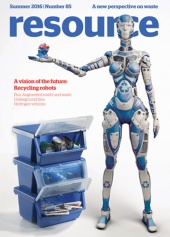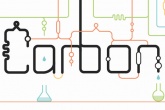Carbon Index 2016: Northern Ireland trumping England's recycling efforts
Simon Hann introduces Eunomia’s fourth Local Authority Recycling Carbon Index, examining one of recycling’s key achievements: carbon reduction.
What good does recycling do? It’s a question householders are entitled to ask as efforts to promote resource recovery gradually ramp up – and so it’s a question that councils should want to be ready to answer.
The benefits of recycling, though, are many and varied, making them tricky to explain and quantify. That’s where we hope Eunomia’s Local Authority Recycling Carbon Index comes in. The study quantifies two of recycling’s key benefits – avoiding the disposal of waste, and the extraction of raw materials – in terms of the resulting reduction in carbon dioxide emissions per person for each authority.
The estimates in the Carbon Index, now in its fourth year, are based on tonnages reported by councils through WasteDataFlow for 2014/15, combined with carbon savings estimates derived from Zero Waste Scotland’s Carbon Metric. The Carbon Index, therefore, provides an alternative to tonnage-based recycling rates in assessing the performance of councils’ collection systems. An authority that collects a lot of green waste for composting, for example, but rather less dry recycling may have a high recycling rate but will occupy a lower rank on the Carbon Index, due to the greater carbon emissions benefit associated with recycling metals, plastics and paper.
The latest edition of the index shows that, despite a slowdown in its rate of improvement, Wales is maintaining a significant lead over England and Northern Ireland. In England, the carbon savings picture reflects the plateauing we have seen in recycling tonnages. Northern Ireland has bucked the trend and improved by five per cent, overtaking England in CO2 terms.
Although the overall picture in England may not have changed, around half of English authorities’ recycling services improved their carbon performance. Wales saw 64 per cent of councils improve, whilst Northern Ireland fared even better with 77 per cent showing an upward trend. Especially noteworthy is Middlesbrough Council, which introduced a new collection system in 2014 and achieved the biggest single year improvement of any authority.
As 2020’s 50 per cent recycling target focuses minds (regardless of the referendum result), we’re seeing renewed interest in separate collection of food waste. The Carbon Index report highlights authorities collecting the most per person. Eight of the top 10 are Welsh, with Merthyr Tydfil topping the table by collecting around 46 kilogrammes (kg) per person. This represents just under half of the average annual UK person’s 109kg food waste – over a kilo per day for a family of four!
Overall, councils collected eight per cent more food waste than in 2013/14 – despite only 37 per cent offering separate food collections. A further 26 per cent collect food mixed with garden waste, which tends to produce lower yields. However, boosting yields is not the whole story. Around 60 per cent of food waste is preventable, so while much more could be collected, councils also need to keep promoting food waste reduction.
In carbon terms, separately collecting organic waste produces quite moderate benefits. Organic waste accounts for 45 per cent of the UK’s municipal recycling, much of this being garden waste. However, this represents less than five per cent of the carbon benefit achieved.
 This article was taken from Issue 85
This article was taken from Issue 85Another material stream that tends to be downplayed by a CO2-driven approach is waste electrical and electronic equipment (WEEE). It is surprisingly difficult to quantify the carbon benefit of recycling household electricals, as treatment practices vary greatly and a great deal of the benefit depends on the process used to recycle each item. Despite our conservative assessment of the contribution that WEEE makes to CO2 savings, though, the authorities collecting the most were almost exclusively the better performers in the Carbon Index, suggesting they have developed effective collection systems overall.
It is estimated that 23 per cent of council-collected WEEE could be reused, but they are instead often crushed or dismantled to allow recovery of the valuable materials they contain. Working with charities, producers and others to repair electrical items before selling them on could also offer councils a revenue stream, estimated to be worth around £100 million across the UK. Councils’ collection infrastructure puts them in a unique position to facilitate a significant expansion of WEEE reuse, which would boost CO2 emission avoidance. We’ll be doing further work to improve the quantification of the carbon benefits of WEEE reuse and recycling in preparation for future editions of the Carbon Index.

An interactive version of the Carbon Index showing the results for each local authority in England, Wales and Northern Ireland is available online on Eunomia's website.







